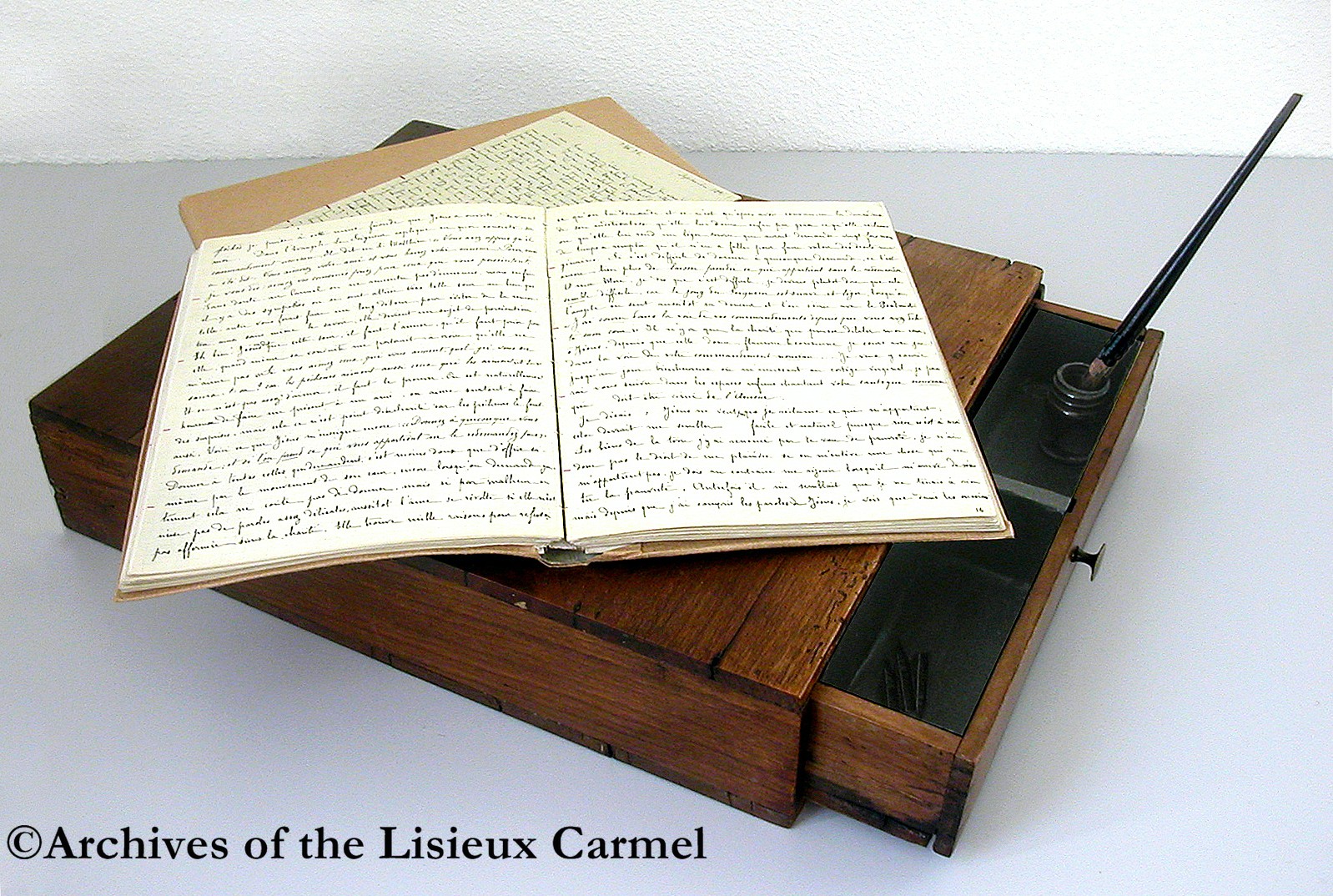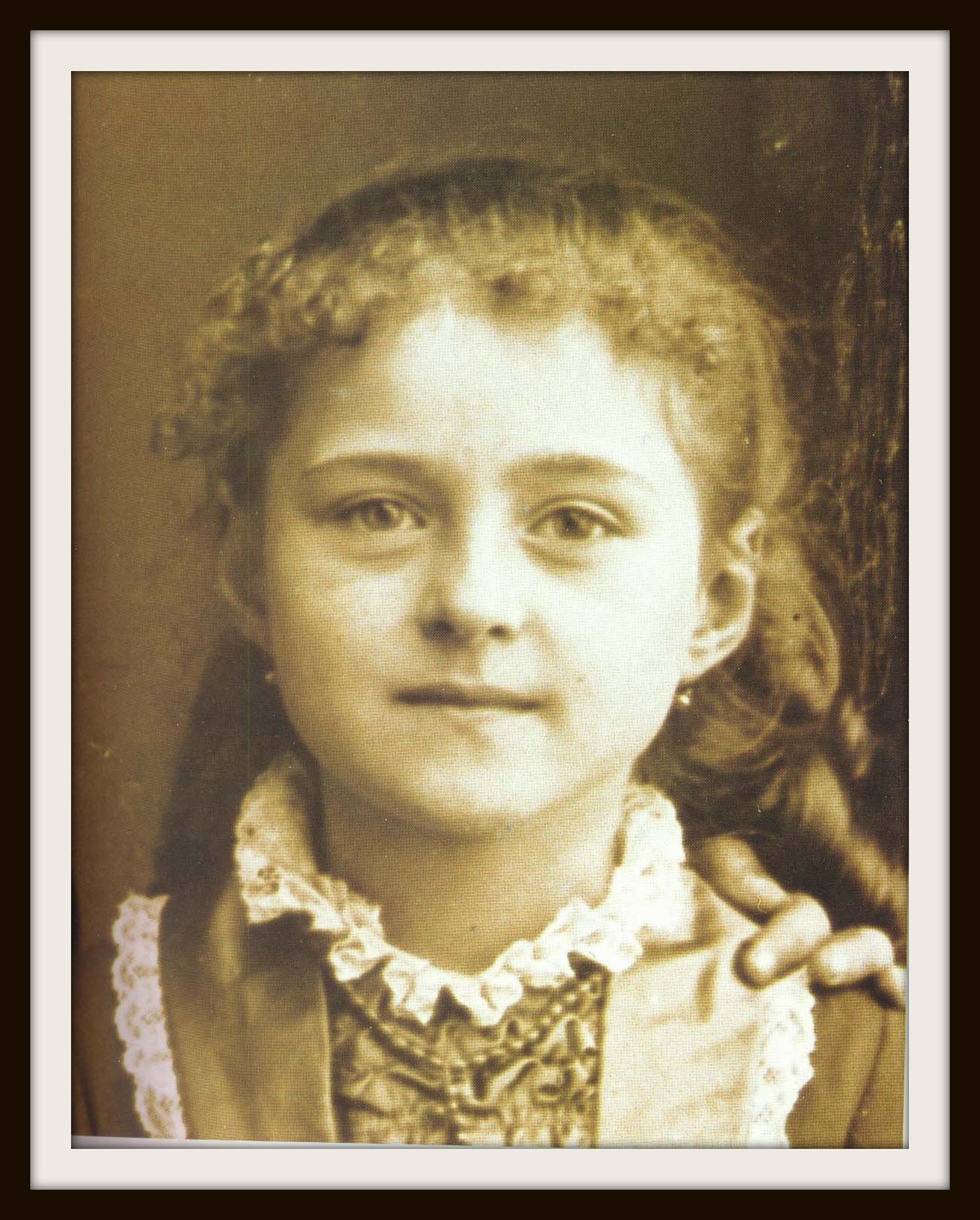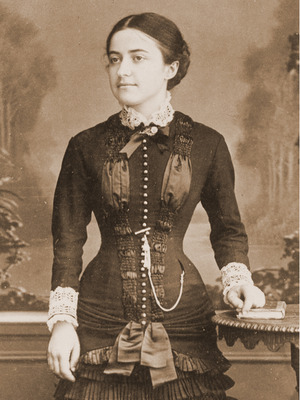Saint Therese of the Child Jesus
of the Holy Face
Entries by Maureen O'Riordan (555)
St. Therese's sister Celine entered the Carmel of Lisieux 120 years ago today, on September 14, 1894
 "Celine. Sister and Witness of St. Therese of the Child Jesus," by Stephane-Joseph Piat. The cover shows Celine, left, at twelve; Therese, right, at eight, 1881.
"Celine. Sister and Witness of St. Therese of the Child Jesus," by Stephane-Joseph Piat. The cover shows Celine, left, at twelve; Therese, right, at eight, 1881.
120 years ago today, on September 14, 1894, Therese's sister Celine entered the Carmel of Lisieux at the age of 25. She had taken care of her father until his death six weeks before, on July 29, 1894.
Celine's story is told in the book Celine: Sister and Witness of St. Therese of the Child Jesus by a Franciscan priest, Stephane-Joseph Piat, who knew her well in her later years. (She died on February 25, 1959, at the age of 89). She herself tells the story of the three years she spent with Therese in Lisieux Carmel in her memoir My Sister Saint Therese, first published in French in the 1950s.
Celine had lived much longer "in the world" than her sisters. From the age of seventeen she had been in charge at Les Buisonnets. She had accompanied her father during his confinement in a mental hospital; nursed him, together with Leonie, and managed his household after his release; participated in the social life of the family of her uncle Guerin; refused two proposals of marriage; considered joining the Jesuit Father Almire Pichon in an apostolate in Canada; been an active member of her parish; organized other young women in charitable and apostolic works in Lisieux; and vigorously pursued studies in art, photography, and other fields. Because she had looked after her father and managed his household, and because of her strong personality, incredible energy, and many talents, Celine's early adjustment to the Carmelite way of life, which at that time was so rigid (for a guide to all its minute customs, see the "Paper of exactions" at the Web site of the Archives of the Carmel of Lisieux) was a challenge. Like so many of us do, she often compared herself with Therese and became discouraged despite her courageous efforts.
Read her eyewitness testimony about Therese at the 1910 diocesan process in the book St. Therese of Lisieux by those who knew her at
At the Web site of the Archives of the Carmel of Lisieux, read the circular of Sister Genevieve of the Holy Face, an account of her life which was prepared at Lisieux and sent to other Carmels at Celine's death.
Read an online biography of Celine on the Web site "Martin Sisters."
September 14, 1894 was an historic date in Carmel not only because of the entrance of the young woman who would give us such valuable testimony about her sister-saint but also for several other reasons:
To make room for Celine, the cells were moved around, and it was to prepare for September 14 that Therese moved into her last cell, which she occupied from then until she left it for the infirmary on July 8, 1897
 writing-desk on which St. Therese wrote the three manuscripts of "Story of a Soul"
writing-desk on which St. Therese wrote the three manuscripts of "Story of a Soul"
When Celine entered, Therese passed on to Celine the ecritoire (small wooden writing-desk held on one's lap) that she herself had been using. Therese replaced it with another, no longer fit for use, which she had found in the attic. So it's on this last, somewhat battered writing-desk, which was displayed in the United States in the summer of 2013, that Therese wrote the three manuscripts of "Story of a Soul"
and all her letters to her spiritual brothers, the young priest Adolphe Roulland and the young seminarian Maurice Belliere.
Celine brought with her a small notebook in which she had copied out extracts from her uncle's Bible. She passed this notebook on to Therese. Since the nuns did not have Bibles, some of the passages were new to Therese. It was in this notebook that Therese found the Scripture passages that were the foundation of her "way of confidence and love": "If anyone is little, let that one come to me." "For to the one that is little, mercy will be shown." "You shall be carried on the knees and fondled at the lap."
Celine also brought that day another object that would be important to the spread of Therese's message: the photographic apparatus with which most of the photographs of Therese as a Carmelite were taken.
May Celine (Sister Genevieve of the Holy Face) obtain for us the grace to enter into following her sister's way of confidence and love with the same energy and courage with which she entered Carmel.
Cross the threshold of the Carmel of Lisieux with St. Therese of Lisieux. September 13, 2014
Entrance of the monastery from Carmel de Lisieux on Vimeo.
The Carmelites of Lisieux welcome you to a "virtual visit" in English to their monastery. In this first video (3:20), see the entrance to the monastery; the enclosure door through which Therese passed on April 9, 1888; and the open cloisters. Hear Therese's words in English, recreating that occasion. English subtitles explain what you are seeing.
Sunday, October 5, 2014 at 1:00 p.m.: "A Map of St. Therese's Way of Confidence and Love"
An Encounter with St. Thérèse of Lisieux
and her parents, Blessed Louis and Zélie Martin
Pray in the presence of their relics on Sunday, October 5, 2014
from 10:00 a.m. to 4:00 p.m.
 Therese Martin at the age of eight in 1881
Therese Martin at the age of eight in 1881
“A Map of the Way of Confidence and Love
of St. Therese of Lisieux"
- a conference by Maureen O’Riordan at 1:00 p.m.:
Benediction of the Blessed Sacrament at 3:30 p.m.
Carmelite Monastery Bookstore Open
1400 66th Avenue 10:00 a.m. to 3:30 p.m.
(66th Avenue and Broad Street) Spiritual books,
Philadelphia, Pa. children's books, DVDs,
Free parking in monastery lot and religious articles.
on 66th Avenue Cash and checks only
Chapel is handicapped-accessible.
Download the flyer
Visit the Web site "Discalced Carmelites of Philadelphia."
Newsletter about the Philadelphia Carmel as the birthplace of devotion to St. Therese of Lisieux - September 5, 2014
 The four foundresses of the Philadelphia Carmel in the chapel on Poplar Street
The four foundresses of the Philadelphia Carmel in the chapel on Poplar Street
See today's newsletter promoting the series of four articles about the Philadelphia Carmel as the birthplace of devotion to St. Therese of Lisieux at http://archive.constantcontact.com/fs197/1106579332794/archive/1118427543568.html
Letters from St. Therese's Sister Pauline, Mother Agnes of Jesus, to Sister Stanislaus of the Blessed Sacrament, 'Philadelphia's Little Flower' - Part 3, 1909-1911 - September 4, 2014
Read part one, "Sister Stanislaus of the Blessed Sacrament, 'Philadelpha's Little Flower'
Read part two, "Letters from St. Therese's Sister Pauline, Mother Agnes of Jesus, to Sister Stanislaus of the Blessed Sacrament, 'Philadelphia's Little Flower,' 1902-1909."
Read "St. Therese of Lisieux and Sister Mary of St. Joseph," which recounts the efforts of Sister Stanislaus’s childhood friend and fellow apostle, Sister Mary of St. Joseph, to make the spirituality of St. Therese known and loved.
 Mother Agnes of Jesus (Pauline Martin) as a laywoman. Photo credit: Web site of the Archives of the Carmel of Lisieux.
Mother Agnes of Jesus (Pauline Martin) as a laywoman. Photo credit: Web site of the Archives of the Carmel of Lisieux.
In the later years of the correspondence between Mother Agnes of Jesus, St. Therese's sister Pauline, in Lisieux and Sister Stanislaus of the Blessed Sacrament in Philadelphia, St. Therese's popularity was increasing dramatically. From July 1908 to July 1909, the Carmel of Lisieux had received more than 9,000 letters about Sister Therese from all five continents. Steps were being taken to introduce her cause. On May 8, 1908, Mother Marie-Ange of the Child Jesus, a saintly young nun who was wholeheartedly devoted to following St. Therese, was elected prioress of the Lisieux Carmel. That same day she wrote to the local bishop asking him to open an inquiry into the life and virtues of Sister Therese of the Child Jesus. On October 15, 1907, Bishop Lemonnier asked the Carmelites to write down their memories of Sister Therese of the Child Jesus. In Part 2 of this article, we had left Mother Agnes and Sister Stanislaus in January 1909. That very month Father Rodrigo of St Francis of Paola, a discalced Carmeite friar, was appointed postulator of the Cause, and Mgr Roger de Teil, canon of Notre-Dame Cathedral in Paris, was appointed vice-postulator.
About this time Sister Stanislaus sewed an outfit for the small statue of the Child Jesus that stood in the cloister of the Lisieux Carmel and which had been the special care of Sister Therese of the Child Jesus. On March 31, 1909, Mother Agnes wrote to Sister Stanislaus in Philadelphia to assure her that she had touched the robe to the statue of the Child Jesus and also to the statue of the Virgin that had smiled on Therese as a child: 'I have asked him to bless and kiss his little seamstress."
Again, as in her letter of July 17, 1903, Mother Agnes uses language suggesting that Sister Stanislaus has asked to see Therese's unpublished writings:
My dear child, regarding the pages of which you speak; you will read them only in heaven … but have patience, the exile is short. You will come up there into your little family. You are part of it, and there you will learn so many things! May it suffice you in this world to know that Thérèse has suffered much and has loved in proportion.
Mother Agnes acknowledges a gift from a friend of the Philadelphia Carmel and says that she can't fill an order for more rose petals or for certain books: "We do not have one single copy. All our books really have wings." Less than a dozen years after the death of Therese, the demand for souvenirs and writings was overwhelming.
Meanwhile Therese showed her affection for the Philadelphia Carmel. In this spring of 1909, Mother Gertrude had an attack of pneumonia complicated by heart disease. She received the Sacrament of the Sick. The community made a novena to Sister Therese for her cure. On the last day of the novena, Mother Gertrude recovered. On August 19, 1909, Mother Agnes wrote acknowledging that she had received the story of Mother Gertrude's cure. Sister Stanislaus had also experienced the mysterious perfumes with which Therese had also blessed the nuns at Lisieux after her death: sudden scents or flowers or of incense. When Sister Stanislaus opened a certain letter, she detected such a perfume. She must have doubted the phenomenon, for Mother Agnes writes "Oh, no, it was not of the imagination, but truly reality; be persuaded and rejoice fully in this gift." Nother Agnes asks Sister Stanislaus to copy out the text of this letter for her.
Mother Agnes speaks of the "perfume of suffering," for her young prioress, Mother Marie-Ange, is very ill (she would die in November) and has just received Extreme Unction, as the Sacrament of the Sick, then usually administered only to the dying, was called. She speaks of having received visitors who were friends of the Philadelphia Carmel.
It appears that certain books about Therese, translated into English, were then available in Great Britain but not in the U.S., and Mother Agnes refers Sister Stanislaus to Father Thomas Nimmo Taylor in Glasgow for information about these books. It appears that Sister Stanislaus and Mother Gertrude both corresponded with Father Thomas Taylor, who by this time was in touch with several English-speaking convents where Therese was loved. In 1910, when he testifies at the diocesan process for Therese, he will name the Philadelphia Carmel and quote from a letter he received from it:
In the United States, she has friends at the novitiate of the Sisters of Charity in Emmitsburg, and at the Philadelphia Carmel A letter from this Carmel speaks of “devotion to Sister Therese among rich and poor, priests and bishops.
As usual, Mother Agnes acknowledges having received payment and new orders from Philadelphia. She also speaks of an account of Therese's Cause, which she will later send to Philadelphia.
Mother Agnes closes tenderly:
For you, my little child, I kiss your forehead as I used to kiss the pure forehead of your sister in heaven.
On September 28, 1909, Isidore Guerin, the maternal uncle of the Martin sisters, died in Lisieux. On October 7, 1909, Mother Agnes writes to Sister Stanislaus: "We have just lost a benefactor in the person of my holy uncle, Monsieur Guerin. Pray for him; he was a Tertiary of Carmel." She mentions that Mother Marie-Ange is "near her last moments" and asks for prayers for her. She asks about the health of Mother Gertrude, saying "this news interests me very much." Again, she ends affectionately:
Goodbye now in Jesus, my little Stanislaus. May His love embrace you, may He find in you the same delights that He used to find before, in the heart of Thérèse!
In Lisieux, Mother Marie-Ange died on November 11, 1909. Mother Agnes replaced her as prioress; she would remain in this office for the rest of her life. On April 1, 1910, Mother Agnes writes again. Her tone suggests that she is late in answering a letter from Sister Stanislaus, for she calls herself a mother who "has more time for loving than for telling it and writing it." She says that she has sent the circular (death notice and life story) of Mother Marie-Ange, and has sent information about "the dear Cause which is as precious to you as it is to us; I truly feel it is so." This is a remarkable testimony of the depth of the fellow-feeling that existed between the Carmels of Lisieux and Philadelphia as early as 1909.
Mother Agnes laments knowing no English and says rather amusingly that she has no faith in the translations of Sister Therese of the Eucharist, a Carmelite of Lisieux who knew some English. Sister Therese of the Eucharist was the subject of a small biography, perhaps her "circular," published in French under the title “Mere Therese de L'Eucharistie Religieuse Carmelite de Lisieux 1885-1915. Carmel de Lisieux, 1916. Hardcover, 11x18cm. Il faut que les petites victimes d'amour soient immolees tout entieres.119pp.” According to Stephane-Joseph Piat's Celine: Sister and Witness of St. Therese of the Child Jesus, Therese of the Eucharist served as novice-mistress at Lisieux. With Marie-Ange of the Child Jesus and Isabel of the Sacred Heart, she completed a troika of saintly young Carmelites attracted to the Lisieux Carmel after Therese’s death. Like Therese, all three died young.
Three days after Mother Agnes mailed this letter, Bishop Lemonnier asked for all of Therese's writings to use them in the inquiry into her holiness, known as the "Process of the Writings," which began on May 23. On July 9, 1910, the Carmelite nuns in Philadelphia moved from their home at 44th and Spruce into "Hill Top," the farmhouse then standing on the land in the Oak Lane neighborhood of Philadelphia where their monastery stands today. By this time Sister Stanislaus of the Blessed Sacrament is very ill. In August she has a severe attack of gastritis.
On August 3, 1910, the diocesan tribunal to open the informative process (also called the "ordinary process" or the "bishop's process" is established at Caen. The diocesan process opens on August 12, 1910. Over the course of a year, the tribunal heard 48 witnesses, of whom the first was Mother Agnes, who testified from August 12 to 19, 1910 and again from August 27 through September 15, 1910. During her second session as a witness, on September 6, 1910, Therese's body is exhumed from the Carmelite plot in the town cemetery at Lisieux. (Exhumation of the body, though no longer mandatory, was at that time necessary for a candidate for sainthood).
Eleven days after she completes her testimony, on September 26, 1910, Mother Agnes writes to Sister Stanislaus again. Mother Agnes states that “the diocesan tribunal is sitting at this time to collect our depositions” and asks for prayers. On the day she wrote, she and Sister Marie of the Sacred Heart had already finished their depositions. Sister Genevieve, Celine, was testifying at this time (from September 14-28, 1910).
Mother Agnes says that the Carmel receives up to 92 letters a day and that this correspondence takes much time, so she writes only briefly to Sister Stanislaus. As if in answer to a request, she says “I can no longer send out anything of Mother Marie-Ange.” She writes that her two blood sisters “do not forget" Sister Stanislaus.
Meanwhile, in Philadelphia, Sister Stanislaus tries to resume her duties, but, by December, she has to stay in bed. On December 25, 1910, the Carmelites of Philadelphia had just finished a novena to the “Little Flower” for the cure of Sister Stanislaus. No longer able to walk, she is carried to Midnight Mass. On january 26, 1911, she receives the last sacraments. In February 1911 an epidemic of influenza ravaged the Lisieux Carmel. On February 5, 1911, Mother Agnes wrote her last surviving letter to Sister Stanislaus. Mother Agnes knows that Sister Stanislaus is ill, but the tone of her letter suggests that she is not aware that her young sister is dying. She urges Sister Stanislaus to take care of herself and to profit by the illness to advance on the path of Therese. She also marvels at the miracle Therese had worked at the Carmel of Gallipoli. Mother Agnes concludes:
Let us run together, my little child, in this child’s path, in confidence and abandonment. I know that you no longer have good legs but the wings of your soul must be substituted.
With these words Mother Agnes unknowingly closes her remarkable correspondence with the young Carmelite of Philadelphia who had done so much to make her little sister known and loved. Sister Stanislaus, now aged 31, will take flight "with the wings of her soul" to Heaven on March 10, 1911. One day I will write Part 4 of this article will tell the story of the death of Sister Stanislaus of the Blessed Sacrament and the letter about her which appeared in the appendix to the 1912 English edition of Story of a Soul.